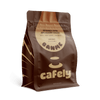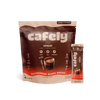Are you concerned about rising energy costs?
Or are you looking to keep your favorite coffee maker powered up while you’re on a camping trip?
Knowing the wattage of your coffee maker can save you from blowing a fuse, draining your power supply, or increasing your energy bill.
In this article, we cover the wattage of the most common coffee machines, teach you how to calculate the running costs, and much more.
How Many Watts Does a Coffee Maker Use?
Generally, most coffee makers fall into a broad range of wattages — between 550 W and 1500 W.
So, what does that mean exactly?
Essentially, those numbers represent how much power the coffee maker uses when it’s using all of its functions.
However, the actual science and engineering behind the scenes isn’t that simple — different processes a coffee maker carries out could use more or less energy. For instance, heating water takes quite a lot of energy, while keeping a single LED bulb lit takes very little.
These factors are why the range of power consumption is so wide — coffee makers do a lot of things, and they’re not constantly doing any of them. You might ask a coffee maker to make one cup of coffee in an hour or a dozen — those two machines will use different amounts of power, so calculating the exact number can be difficult.
Wattage Used At Different Brewing Stages

Generally, the role of a coffee maker is easy to break down into three core steps — grinding coffee, heating water, and pumping water.
Coffee Grinder Wattage
Grinding coffee is not exceptionally energy-intensive. The grinder consists of heavy, durable burrs. The heaviness and durability of those components are what does most of the work of grinding coffee, so a powerful grinder may only need quite a small motor actually to spin the burrs.
Standalone coffee grinders range between 150 and 200 watts. Most grinders built into a coffee maker are on the smaller side since they have to fit into a machine alongside other complex parts.
Heating Water Wattage
Heating water is more energy-intensive, especially if your coffee maker isn’t well insulated.
Standalone kettles and water heaters typically require between 1200 and 1500 W. Even if the kettle isn’t running at that power constantly, it needs that high level of power draw to create enough heat to boil water.
More often than not, this is the most energy-intensive stage of the brewing process for your coffee maker.
Water Pumps (Keurig/Espresso)
Finally, we come to pumping water. Though there's a lot of complicated physics involved in different types of pumps and pipes, even high-pressure pumps like espresso machines don't have a high wattage.
Pumps sold as spare parts for coffee makers typically vary between 28 and 48 watts.
Different Coffee Machines
Now that we’ve broken down how much different jobs within a coffee maker “cost” in terms of wattage, we can start to understand how much your coffee maker might need.
Generally, a small drip coffee maker uses between 550 and 900 W, with larger versions clocking in at up to 1200 W.
Pod machines are a little more intensive, with most being between 900 and 1500 W.
Finally, the coffee makers that are among the most power-hungry are fully automatic espresso machines, which are often between 1000 and 1500 W.
How To Find the Wattage of Your Coffee Maker
In most places around the world, it’s a legal safety requirement to have the wattage, amperage, and voltage written on the machine itself or, at least, on the plug to which it’s attached. If you want to know your coffee maker's exact wattage, look at the back of the machine or the manual that came with it.
Here are some popular coffee machines and their wattages:
|
Coffee Maker |
Wattage |
|
Keurigs |
1500 |
|
Nespresso VertuoNext |
1260 |
|
Nespresso CitiZ |
1710 |
|
De’Longhi Manual Coffee Machine Stilosa |
1100 |
|
De’Longhi Nescafé Dolce Gusto Piccolo |
1600 |
You Know The Wattage — Now What?
There are two main reasons why you might be concerned about power consumption — knowing how much you’re spending at home or ensuring you generate enough power while camping.
Let’s look at some specifics:
Calculating Running Costs
If you’re concerned about how much your electricity bill costs, looking at high-powered appliances is a sensible place to start. Items with a heating element are usually the most power-hungry. Therefore, running your coffee maker might cost you a little more than expected.
For example, let’s take the median wattage for coffee makers — 1,025 watts, or 1.025 kilowatts (kW) and the average cost of electricity in the US — around 17 cents per kWh. By multiplying the cost per kWh by the wattage, running your coffee machine for an hour would cost 17.425 cents.
While you can use this as a general measurement of how much you’ll pay per hour for a coffee machine, there are many factors to consider. For example, the brewing function takes up the most energy, while the coffee warmer takes much less. However, this can still give you a good idea of how much this will cost daily.
Finding the Right Generator for Your Coffee Maker
If you're planning to take your coffee maker on your next trip to the great outdoors, you must have the right generator for the job. Start by checking the wattage of your coffee maker, as that's what the generator will need to provide at a minimum.
Generators are rated by how much power they produce in watts. For instance, a generator may be rated to produce 1800 W at maximum capacity, meaning it can produce that amount at a time. If you plug in your 1000 W coffee maker, you can only then add other appliances if their wattage is 800 W or less. If you exceed the 1800 W total, the appliances will stop working.
So, to find the right generator, consider what appliances you’ll have plugged in at the same time. Calculate how much wattage your coffee maker will take, plus any appliances you usually have plugged in. Once you have all the individual wattages, add them together. That figure will be the maximum amount of watts that you can draw at any time, so you must buy a generator that’s rated to produce more than that number.
Making Your Coffee Maker More Economical

Here are some tips you can use to cut back on your coffee-making energy consumption — or use zero energy at all.
Heating Water
Heating water is the most power-hungry part of the coffee-making process. Whether in your home or camping, there’s one alternative to electricity — fire.
In your home, if you have a gas stove, you may want to invest in a stovetop coffee maker like a Moka pot. This can make a delicious espresso-like coffee with little to no electricity. While camping, you can use the moka pot over hot coals or a gas stove. You can also heat a kettle of water the same way, add instant coffee to your cup, pour in the hot water, and enjoy.
If you’d prefer to just avoid heating water at all, you can make cold-brew coffee. However, this method can take a long time, so it may be worth making a stock of cold-brew coffee before a camping trip or before you usually have that first cup in the morning.
Grinding Coffee
Grinding coffee isn’t very energy intensive, with most coffee grinders coming in at the low hundreds of watts. However, if you’re looking to shave off every watt you can or live completely off-grid, there are many analog versions.
People have been hand-grinding coffee for centuries, and the technology has remained largely unchanged. Nowadays, you can typically find ceramic burr hand grinders online for a reasonable cost, and they’re typically quite easy and quick to use.
The main downsides of hand grinders come down to two things — it takes a lot of effort, and they can’t grind a lot of coffee at once. These analog grinders are usually designed for one cup of coffee, which might not be worth the time and effort for many. However, these devices are particularly popular with campers, and some companies offer grinders that can fit within the hollow plunger of an Aeropress.
Manual Brewing Methods That Require No Electricity

If you’re accustomed to using your electric coffee maker for a lot of coffee making, then you might be surprised to learn just how many different manual coffee-making tools there are.
Here are some great manual brewing options with a brief breakdown of their brewing processes:
1. French Press
French press is perhaps the manual brewing method that most people are familiar with. This immersion brewer works by submerging coarse-ground coffee in hot water for a few minutes. The grounds are then separated by pushing the plunger (a metal mesh filter) through the brew.
2. Aeropress
As the more modern coffee invention, the Aeropress brewer is essentially a thick plastic syringe. You add coffee and hot water to the inside of the syringe, seal it off with filter paper and a secure cap, then press the plunger down to dispense coffee.
Coffee enthusiasts love the Aeropress for many reasons, including its indestructibility, ease of use, and quick brew time. The Aeropress mixes bean immersion with pressure extraction, leading to an intensely flavorsome cup of coffee.
3. Pour-Over
Pour-over brewing can be a little intimidating, especially when you read the coffee-obsessed step-by-step directions. However, the actual method itself is fairly easy to learn and often considered quite meditative. The easiest way to describe it is through its title — pour hot water over coffee, and let the filter do the rest.
This makes it a popular analog brewing method and a great way to get amazing-tasting coffee on a budget.
4. Phin Filter
The phin is a Vietnamese brewing method that’s both simple and powerful. The brewer consists of a simple metal chamber with a filter at the base to which you add coffee and water. Then, you place a weight on top of the brewing mixture and a lid on top of that.
The resulting coffee drips through the fine mesh filter very slowly, and the constant application of pressure leads to high extraction rates. For a strongly caffeinated and flavorful brew, a phin filter is a great choice.
5. Instant Coffee
Coffee connoisseurs often turn their noses up at instant coffee, but brands now produce high-quality instant coffee that tastes almost the same as freshly brewed pot. These are perfect for camping or a quick afternoon brew. Pour hot water over the coffee, stir, and you’re ready to drink.
To get the best instant coffee, look for one with natural sweeteners instead of added sugar. Instant coffee made with natural sweeteners can tend to have a more complex flavor.
FAQs: How Many Watts Does A Coffee Maker Use?
Now that we’ve delved into the complex world of electrical engineering, let’s answer some FAQs.
1. Will a 1000 Watt Inverter Run a Coffee Maker?
That depends on the coffee maker. A 1000 W inverter can run a coffee maker that consumes less than 1000 W.
2. How Many Watts Do You Need to Run a Coffee Maker?
Running a coffee maker can “cost” different amounts of watts depending on the machine's functions. Generally, the wattage of a coffee maker can range between 550 and 1500W, with more watts needed in machines that heat large amounts of water.
3. Does a Coffee Maker Use a Lot of Electricity?
A coffee maker can use a lot of electricity, with the average machine using around 1000 watts of power per hour. This is the same wattage as many small heaters or powerful microwaves, though the actual brewing process won’t be constant.
4. Will a 2000 Watt Inverter Run a Coffee Maker?
Yes, a 2000-watt inverter will have enough power to run most coffee makers. Coffee makers range between 550 and 1500 W, so an inverter that produces 2000 W should be more than enough.
5. Will a 1000 W Inverter Power a Kettle?
Kettles tend to vary in wattage between 1,200 and 1,500. So, a 1000 W inverter might not be enough for a standard kettle. However, you may be able to use a travel kettle that’s smaller and requires less power.
6. What Can I Run Off a 1000 W Inverter?
A 1000 W inverter can power several different things, though it may only be able to power one or two power-hungry appliances at a time. For instance, a powerful microwave may be rated at 1000 W, so when it’s running, no other appliances can be used alongside it.
7. How Many Watts Does a Ninja Coffee Maker Use?
Ninja makes several different coffee makers, ranging between 950 W and 1775 W. For the exact wattage of your Ninja coffee maker, consult the manual.
8. Will a 400 Watt Inverter Run a Coffee Maker?
No, it’s unlikely that a 400 W inverter would be able to run a coffee maker. Most coffee makers vary in wattage between 550 W and 1500 W, so a 400W inverter wouldn’t have enough power.
9. What Size Generator Do I Need To Run A Coffee Machine?
Different coffee machines require different amounts of watts to run safely and effectively. You’ll need a generator capable of producing more than 550 to 1500 watts, depending on the kind of coffee you’re making. To get an exact number, check the manual that came with your coffee maker.
10. Does Leaving a Coffee Machine Plugged in Use Electricity?
This depends on the exact functions of your coffee machine. Many coffee machines have a “standby” mode where they may display the time or have a few LED bulbs lit when not actively brewing coffee. This will use electricity, though likely not very much. If your coffee maker continues to produce some amount of heat or light while plugged in, it’s likely using electricity.










